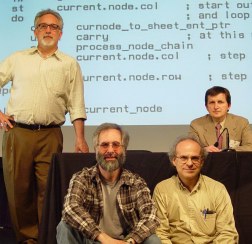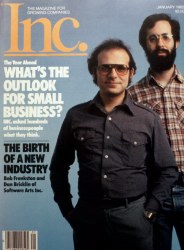Birth of an Industry 
Unfortunately I couldn't go last night, luckily and made Scott did and here is his account:

As the father of twin three-year-old boys, I don't get out much, I'm sorry to say. But I did head down to Silicon Valley last night for a special event hosted by the Computer History Museum. Titled "The Origins and Impact of VisiCalc," the panel discussion featured Dan Bricklin, who dreamed up VisiCalc; Bob Frankston, responsible for coding it; and Mitch Kapor, the father of Lotus 1-2-3, which succeeded VisiCalc in the spreadsheet marketplace. Microsoft's Charles Simonyi moderated.
The story of VisiCalc is the stuff of software-industry legend: It is widely viewed as the original "killer app" for personal computing (though Simonyi said that that term was actually first applied to Lotus 1-2-3 and only later retroactively extended to VisiCalc itself). People would see a demo of the spreadsheet, or see a friend using it, and decide to go out and buy a computer so they could use it.
VisiCalc first achieved its popularity on the Apple II, but it ceded its market to Lotus when the IBM PC arrived: 1-2-3, which was coded to take advantage of the PC's 16-bit processing (the Apple II and CP/M computers popular before the PC were 8-bit) seized the moment of this "platform transition" to take the lead. (The panel, which was being hosted at Microsoft's Mountain View campus, did not touch on the process by which Lotus, in turn, lost out to Microsoft's Excel, as part of Microsoft's cementing of its "Office suite" dominance in the '90s.)
Though this is an oft-told story in the annals of computing, I learned a number of new things from listening to Bricklin and Frankston.
Bricklin explained that his father was a printer and that's how he learned the importance of prototyping, doing quick mockups for customers first before you committed to stuff that was hard to change. He showed a manual page from a typesetting terminal, the Harris 2200, that also served as one inspiration for the spreadsheet, with its separate layers of data, calculations and formatting. He also mentioned that it was his backhround in computerized typesetting that inculcated in him the principle of "keystroke minimization" -- because in that field, people were actually paid by the keystroke.
Bricklin and the other panelists agreed that VisiCalc succeeded because it was different from the kind of financial forecasting software that already existed -- it was a free-form, general purpose tool, an electronic "back of the envelope." It allowed non-programmers to do things at a level of complexity that, previously, you had to learn programming to accomplish.
Bricklin and Frankston recalled that their initial efforts to promote VisiCalc did not meet universal enthusiasm. Experienced computer people weren't bowled over, Bricklin said; they would dismiss the spreadsheet with, "Hey, I can already do most of this in BASIC." People who had no experience with computers tended to think that computers could do anything under the sun, and so VisiCalc didn't wow them. "But when the accountants saw it -- there was an accountant [at a particular computer store], he started shaking -- he said, 'This is what I do all day!'"
 Kapor closed out the discussion with a tribute to this pioneering piece of software: "VisiCalc literally changed my life. It was a complete inspiration. I don't think people remember what impact it had. It had an elegant minimalism -- it got out of your way... My goal in life was to design something that could stand next to VisiCalc without embarrassment." Kapor closed out the discussion with a tribute to this pioneering piece of software: "VisiCalc literally changed my life. It was a complete inspiration. I don't think people remember what impact it had. It had an elegant minimalism -- it got out of your way... My goal in life was to design something that could stand next to VisiCalc without embarrassment."
As someone who was an undergraduate in Cambridge at the same time in the late '70s that Bricklin was dreaming of a "magic typable blackboard" at the Harvard Business School, I found Bricklin's photos from that era (posted on his own Web site here) evocative. Since I spent a lot of time in that era working on Compugraphic typesetting machines, I was amused and intrigued to hear him acknowledge his debt to the world of that technology.
Bricklin also displayed a copy of Inc. magazine from Jan. 1982, with a cover story on "The Birth of a New Industry" and a cover shot of Bricklin and Frankston. (You can see it on Bricklin's site here.) As the photo appeared on the screen at the front of the lecture hall, someone in the crowd shouted, "Same shirt!" Then and now, Bricklin favored the plaid flannel look.
[Scott Rosenberg's Links & Comment] (Bob still wears the same shirts too) (Dan blogged it)
12:00:10 AM 
|

